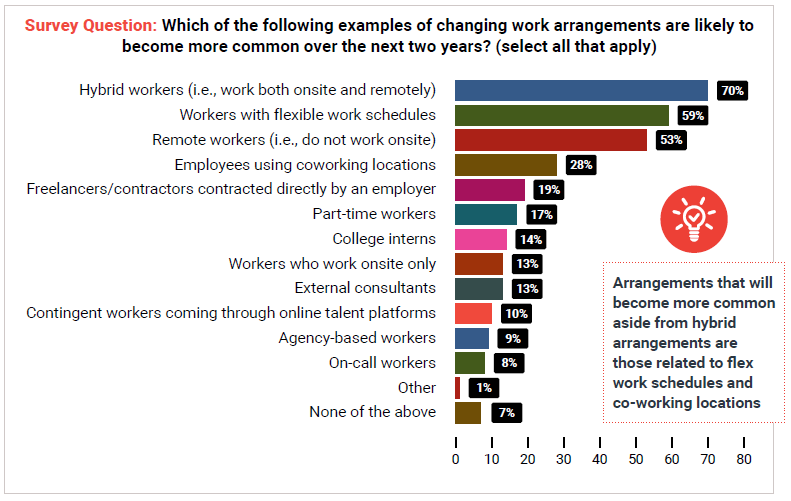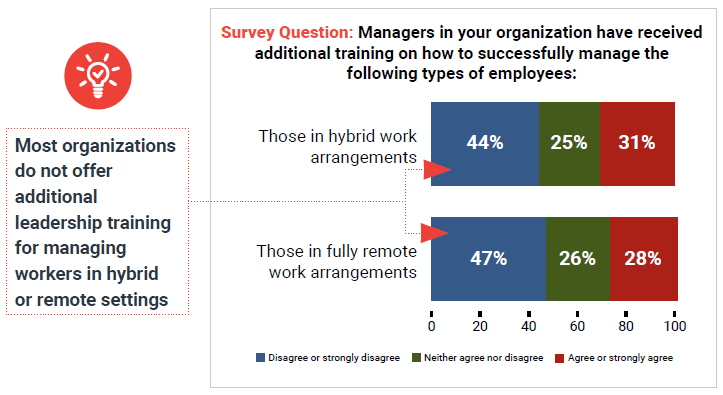
Remote and hybrid work arrangements are the most common types of flexible work arrangements
With increases in flexible work arrangements over the past two years and more increases expected, what types of flexible work arrangements are organizations most likely to utilize?
Remote work still tops the list (74%), with hybrid work arrangements fairly close behind (65%). Hybrid work arrangements tend to incorporate a mix of work in the traditional workplace (e.g., offices, plants, stores) and remote work into workers’ schedules.
While some employers will likely continue with current levels of remote work, others may replace at least some of those arrangements with hybrid work systems. As a result, many employees will continue to require remote access to HR, more effective ways of managing projects, smarter ways of forming and managing remote teams, greater help with work-life balance, and more.
The 2021 Microsoft Work Index found that 70% of employees want flexible options and 65% want the opportunity to work in person with other team members as the pandemic subsides. Obviously, any return to on-site work will be guided first by employee safety.5
However, it is important to point out that our sample includes responses from a range of industries for which some flexible work arrangements are not applicable. For example, retail and health care workers will likely have fewer opportunities for remote or hybrid arrangements.
Hybrid workers could be the future of work
If we look down the road over the next two years, most responding HR professionals indicate that hybrid work arrangements will become more dominant than remote-only work. Seventy percent say that hybrid workers will become more prevalent.
Of course, what these hybrid work arrangements will look like will depend on the organization. For example, one company may require employees to come into the office once or twice a week while another may mandate just once a month.
However, this does not spell the end of remote work. More than half of the respondents (53%) say they expect remote arrangements to be more common over the next two years. Fifty-nine percent also plan on increasing the use of flexible work schedules.
Managers are most likely to decide on the details of hybrid work arrangements for their direct reports
While hybrid work arrangements are becoming the norm across many companies, a crucial question is “who decides the details?”
Almost half of those whose organizations use hybrid work arrangements report that managers make the decisions for their direct reports (48%), and just over a third (36%) report that the balance of on-site and remote work is determined by employer-set schedules. Nearly as many (34%) say that a company policy exists detailing how hybrid works, and 29%
report that upper management decides how hybrid work should be organized.
A little less than a third (31%) of respondents indicate that employees themselves decide on the on-site/remote balance. This indicates that the specifics of most hybrid work arrangements are driven by management. Of course, sometimes several approaches can be used in tandem. For
example, a manager may determine that a hybrid model is best for their department but allow employees freedom around the remote/on-site balance depending on employee needs.
That said, many organizations probably need to have consistent hybrid work arrangements guidelines to avoid a situation where a manager of one department offers more flexibility than another manager, even though both departments do the same type of work.
Differences by size of organization
HR is far more likely to have a say in how hybrid work arrangements operate in larger organizations. While 18% of respondents in large organizations say HR has determined hybrid work arrangements, just 9% of those in small and 5% of those in mid-sized companies say the same.
Fewer than a third of organizations provide additional leadership training on managing employees in remote or hybrid work arrangements
As noted earlier, the most common types of flexible work arrangements are hybrid and remote work. Unfortunately, most managers are not receiving additional training in how to successfully manage employees in these work arrangements.
Fewer than one-third agree or strongly agree that managers in their organization receive additional training regarding hybrid or remote working arrangements.
While good leadership in general is crucial, there may be some areas that require more attention. For example, communicating with transparency, honesty and speed is especially important when workforces are dispersed. Further, forging genuine connections and rapport with direct reports is a skill likely needed for future success.
While many organizations currently do not offer additional training to managers, a majority is likely to do so over the next two years
Although managers are currently not likely to receive additional training in managing remote and hybrid workforces, organizations are recognizing the need to upskill. Respondents say training managers on how to manage different types of work arrangements is the practice
most likely to become common over the next two years.
As we saw earlier, many organizations need to cope with worsening or stagnant corporate cultures. Therefore, we believe it is good news that 51% of HR professionals see the need to reinforce organizational values, and 45% believe that goals and objectives will be used to create greater clarity. Half of HR professionals also see the need to provide remote workers with the right tools and resources to be productive outside of on-site locations. In short, some HR professionals not only want to boost management skills in this area but also want to improve organizational culture and resources as well.
Differences by size of organization
Respondents in large organizations are more likely to say their organization will focus on training managers over the next two years. Just 45% of those in small and 60% of those in mid-sized organizations say their organization will focus on training managers on how to manage different types of work arrangements, while more than two-thirds (68%) of respondents at large organizations say the same.




